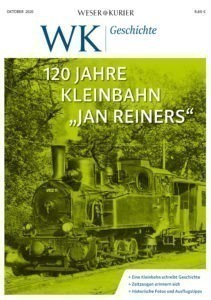Serie zum Kriegsende vor 70 Jahren: Der US-Soldat Tony Vaccaro fotografierte in den frühen Nachkriegsjahren in Bremen
O-Ton 1:
Bremen was really, it was hit more than any other city I’ve ever seen. Just around the statue of Roland was a little standing up, but beyond that it was totally destroyed.
Tony Vaccaro, der das erzählt, kam im Winter 1946 nach Bremen, als amerikanischer Besatzungssoldat – und als Fotograf. Sein Handwerk gelernt hat er im Krieg: 1944/45 kämpfte er als „private“ in der 83rd Infantry Division und wurde Mitglied eines „Intelligence Platoons“, einer Aufklärungseinheit. Was ihn von anderen GIs unterschied, war die Argus C-2, ein 35mm Fotoapparat. Bei Kriegsende hatte Vaccaro fast 7000 Aufnahmen gemacht, bis 1949, als er Deutschland verließ, wurden es 17.000: einfühlsame Zeugnisse von Krieg, Zerstörung und Tod, von moralischer Verwahrlosung und Mitmenschlichkeit, von Hoffnung und Verzweiflung, von Befreiung, Zusammenbruch und Neubeginn.
O-Ton 2:
In one of my pictures, you see, I’m in the middle of the street, and you see the street, nothing on the right, nothing on the left, you know, a church all broken up in the distance (Wilhadikirche). And the title is: Here passed mankind.
Here passed mankind – ein Wortspiel, denn to pass kann vorbeigehen oder auch sterben heißen: „Hier ging die Menschheit unter.“ Im Bremer Westen. Das Sonnenlicht wirft Schatten einer ausgebombten Häuserzeit mitten auf die Straße, da, wo die Fenster einst waren, zeichnen sich helle Konturen auf dem Straßenpflaster ab.
Drei- bis viermal pro Jahr kommt Tony Vaccaro in dieser Zeit mit seinem Jeep nach Bremen. Für die amerikanische Armeezeitung „The Stars and Stripes“ fotografiert er die Hinterlassenschaft des furchtbaren Krieges: Ruinen und Elend, Desorientierung, Perspektivlosigkeit. Mittlerweile gilt sein Mitgefühl der deutschen Zivilbevölkerung. Das war nicht immer so.
O-Ton 3
Knauf: What was your personal attitude towards the german people? Not to germany as a state.
Vaccaro: Oh, the German people at that time was hate. It was my enemy and they tried to kill me and I tried to kill them. And when you’re at that level, you are not longer a human being, you’re a brute, you’re an animal. And, so the cause of me becoming a beast, were the Germans. And I resented that, not because they were my enemy, but because they put me in that position, where I lost my virginity of killing, the innocence of being simply human without having ever committed a murder. And they put me in the position, where I had to do it – every day, try every day, which is a terrible thing to live with.
When you met the first Germans, can you describe the mental state?
Well, I had met them in Normandy, you know. So I was aware of that. The first time, that I met, was, someday they are attacking and we see them running towards us. Like the scene that you see of Normandy, the Americans running towards the Germans, this was in a town called Saint Denis, in Normandy. And here we see them running towards us. And we were ordered to shoot, to kill, aim and kill, don’t to shoot anywhere, aim to kill. And I could not pull the trigger. And the Sergeant starts fighting with me: „You must shoot, you must shoot.“ I could not shoot and I ran back of the line.
I went about 200 yards back, I am in a foxhole and I think thing’s over and then another friend of mine, from Ohio, came over and he said: „Tony, you have no alternative, you could be shot by the Americans for deserting front line.“ His reasoning and my reasoning, I suddenly realised, that the only thing I had, was: Let’s hope, that luck will keep me alive through the war. There is a possibility, that I could make it. And I went back, I took the rifle and with tears in my eyes, I started shooting.
And what about the civilian Germans, when you finally entered Germany?
When I saw the civilian Germans, I felt sorry for them. The first thing before I saw them, there was this hate. But then, when I saw them, I saw, that there was nothing to hate. They all looked very sickly; they all looked very undernourished, very pale. Children, women, old people, because the people are your age, you know younger age; the older were all at the war. So you saw women, children and old people. I felt sorry for them, when I finally saw them.
Im Krieg hasste Tony die Deutschen, sie wollten ihn töten und er wurde gezwungen, auf sie zu schießen. Er hasste sie, weil sie ihn zwangen, seine Menschlichkeit aufzugeben, ihn in den unzivilisierten Stand einer Bestie zurück versetzten. Und doch konnte er mit den Deutschen Mitleid empfinden, als er bemerkte, wie ausgemergelt, unterernährt und demoralisiert sie aussahen; I felt sorry for them. Und dieses Mitgefühl kann man dem Ton seiner Stimme anhören.
Im Herbst 1948 ist Schäfers „Märchenstadt Lilliput“ in Bremen zu Gast. Tony Vaccaro ist so fasziniert, dass er eine Porträtserie von über 30 Fotos schießt.
Überhaupt zeigen seine Bilder jetzt zwar immer noch Ruinen und Elend, aber vereinzelt lachen die Menschen, ein schüchterner Glamour der frühen Jahre deutet sich an. Seine Bilder zeigen nun auch tanzende Kinder und insbesondere die Jungs imitieren die Posen der amerikanischen Sieger.
Tony Vaccaro wurde im Dezember 1922 als Sohn italienischer Einwanderer in Pennsylvania/USA geboren. Bekannt geworden ist er vor allem mit seinen Kriegs- und Nachkriegsfotografien von 1944 bis 1949. Nach Kriegsende arbeitete er als Lifestyle- und Modefotograf. Der 93-Jährige lebt heute in Long Island City/New York.
Noch in diesem Jahr soll ein neuer Film mit dem Titel Long Exposure: The unlikely Journey of Pfc. Tony Vaccaro ausgestrahlt werden.
von Dr. Diethelm Knauf

